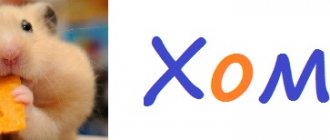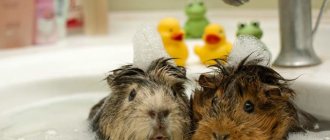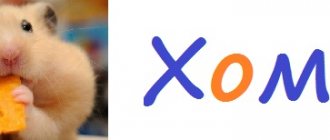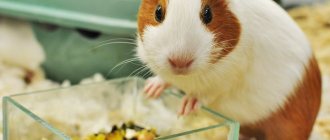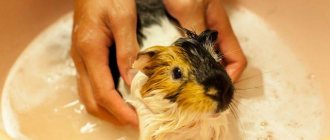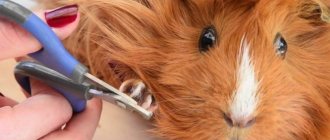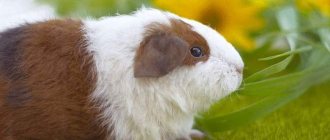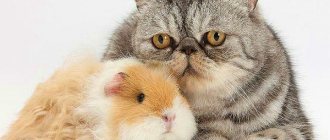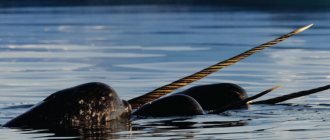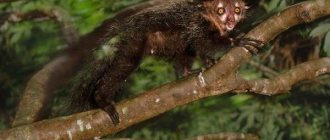Externally, the capybara is very similar to a guinea pig, only larger in size. An adult capybara can reach a length of 1-1.5. m. Males weigh 34-63 kg. Females, oddly enough, are slightly larger, their weight can reach 65.5 kg.
The capybara, despite its size, is a herbivore. The capybara has 20 teeth. No matter how many times a rodent loses cheek teeth, they quickly grow back. The rodent has short limbs. The body is covered with coarse hairs, there is no undercoat.
The capybara is found in South and Central America. It can be seen near warm shores.
The animal spends most of its time offshore, but if it is in any danger, it considers the water a safe place.
Capybaras live in groups of 10 to 20 individuals. One such family can occupy up to 10 hectares of land. Capybaras mark the boundaries of their territory.
The animals live 9-10 years, in captivity up to 12. Sometimes they are kept as pets.
The average weight of a simple domestic guinea pig usually does not exceed 0.8 kg, but in the wild it has large, similar relatives that reach 100 kg. These are the largest guinea pig in the world, called the capybara, and the giant guinea pig, the kui.
The largest guinea pigs
Characteristics of the capybara
The largest guinea pigs are not much different from the simple decorative rodents familiar to us, representing a copy enlarged several times.
External signs
In appearance and the blunt-nosed square structure of the muzzle, large wild rodents have a similar resemblance to miniature domestic ones:
- strong build, large and massive head with a blunt muzzle and widely spaced nostrils, rounded short ears, small eyes.
They grow up to 1.5 m in length, and reach 1 m at the withers. The average weight of a capybara is about 50-65 kg, but among the largest individuals there are weight record holders, gaining weight of 1 centner.
Wild rodents are distinguished by an amazing feature of the growth of their cheek teeth: when one of them falls out, a new one grows in its place. There are 20 of them in total.
The stockiness and clumsiness of the large capybara is given by the different sizes of the paws: the front ones are noticeably longer than the hind ones.
The coat is quite hard and fits tightly to the animal’s body. The coat color of a wild rodent can be red and gray, as well as in its various shades.
Geography of distribution
In its natural environment, the large wild sea capybara can be seen in the tropical regions of South America and the Andes region. Being a land rodent, it still prefers to be located near bodies of water, since if danger arises, water is the only place where the animal can hide.
Each group of large rodents is assigned its own habitat using special pheromones, where strangers are not allowed.
The animals live in small herds of 10-20 individuals with a male leader. They look for food mainly during the daytime. This is a herbivorous rodent, therefore its diet when living in natural conditions includes vegetation, including aquatic ones.
Spreading
The largest rodent in the world lives in almost all countries of Central and South America, preferring a tropical, humid climate and the obligatory presence of various bodies of water - rivers, lakes, ponds. Climatic conditions, namely seasonally constant, high air and water temperatures, determine the boundaries of the animal’s living area.
The climate data below for the year in Caracas (Venezuela) is necessary for the life of capybaras.
Air and water temperatures at 0C by month, number of rainy days:
| Jan. | Feb. | March | Apr. | May | June | July | Aug. | Sep. | Oct. | Nov. | Dec. |
| 22 | 22 | 24,5 | 25,5 | 25 | 26 | 26 | 27 | 28 | 27 | 26 | 25,5 |
| 24,5 | 24 | 25 | 24,5 | 26 | 26 | 26 | 28 | 28 | 28 | 27,5 | 26,5 |
| 3 | 4 | 7 | 14 | 18 | 19 | 19 | 26 | 27 | 26 | 18 | 13 |
The water pig also feels comfortable in wooded mountains (up to 1300 m in height) and in mangrove swamps.
Don't miss the most popular article in the section: Mariana Trench on the world map. Where it is located, what makes it unique, show what’s inside.
Keeping capybaras at home
By its temperament, a large guinea pig is quite friendly and easily makes contact with people. This explains the possibility of keeping capybaras at home. In his small homeland, the animal is often found in the homes of local exotic lovers.
In the wild, the lifespan of a large capybara is about 9 years. With good home care, capybaras can live up to 12 years.
Conditions of detention
Keeping a capybara is practically no different from keeping ordinary guinea pigs, only because of its size it requires a lot of space. They also need a cage where bowls with food, a drinking bowl with water are placed, and filler is poured. At least once a day, the capybara is allowed to roam freely.
Diet
More relatives of domestic kaviya eat the same foods: fruits, vegetables, grains, herbs and hay.
The feeding rate is calculated from the weight of the animal and is 50g per 1 kg of weight for dry food and about 70-80g per 1 kg of weight for juicy food. Hay is given in unlimited quantities and the rodent is always provided with water.
Unlike ornamental rodents, which are harmful to water procedures, wild capybaras love to swim most of all, spending a lot of time in the water. Therefore, in a private house where there is a small pool, the capybara will feel much more comfortable.
Baybak
Another name is common marmot . It lives in the virgin steppes of Eurasia. The English name “Bobak marmot” comes from the Turkic word “ baibak ”, which also means “marmot”.
It is similar to other marmots, but stands out for its yellow coloring and short tail, which does not exceed 15 cm in length. The bobak also stands out for its size: its body length is from 50 to 70 cm, a fattened male can weigh up to 10 kg.
Once upon a time it was a common animal that lived in the steppe zone from Hungary to the Irtysh. But due to the plowing of virgin lands, the amount of area it occupied was significantly reduced, because they cannot live in vegetable and grain crops. Baibaks form perennial colonies and make many burrows for themselves. They feed on plant foods.
Characteristics of kui
Giant guinea pigs called kui are the second large relatives of ornamental cavys, having a similar structure. Although they are called giant, they are inferior in size to large capybaras.
External signs
The average weight of a kui varies about 4 kg, and the length of the rodent grows up to 0.55 m. This is a rodent with a large head compared to the proportions of the body and large bones. Kuya's coat can be soft or hard, curly or straight, and also of different lengths. The color of the animal can be varied:
- black and white, light and dark brown, gray and piebald, golden and sand.
Geography of distribution
The giant Cui guinea pigs are native to Peru. Rodents can be found in Ecuador, Colombia and Bolivia. There they are valued as game animals due to their high-quality meat and valuable skins. Due to their high fertility, these rodents are often bred in households on a par with domestic rabbit breeding.
Soviet chinchilla
Despite the name, we are not talking about a chinchilla at all, but about a breed of rabbits that are bred for their fur. It was bred in the USSR. Our specialists crossed American chinchillas with different breeds and were able to increase the live weight of the animal to 5 kg.
In 1963, a new breed, the Soviet chinchilla, . Its representatives are distinguished by thick fur, high-quality skin, large size, good endurance and early ripening.
Their body is 60-70 cm long, they are silver or dark silver, the belly and part of the paws are black, and there is a border of the same color on the ears. An adult rabbit weighs from 3 to 5 kg, among them there are record holders who gained up to 7-8 kg.
Habitat and behavioral characteristics
In the wild, the largest guinea pig in the world is found in the tropics of South America and the Andes.
She is a direct descendant of the Guinea pig. The animal is land-dwelling, but prefers to settle closer to a body of water. Indeed, in case of danger, a river or lake is almost the only place where a capybara can hide. And she has plenty of enemies - these are wild dogs, and cat predators, and snakes, and other wild animals of the tropics.
They feed mainly during the day, but if they feel threatened or someone is bothering them, they are quite capable of searching for food at night.
They live in small groups, the “family” usually includes from 10 to 20 individuals, over which the male leader dominates. In total, there can be up to five males in the group, but anyone who encroaches on the role of leader will certainly be kicked out in disgrace by the existing boss.
Each herd is assigned its own territory, into which strangers are not allowed. They mark it with special pheromones located in the nasal and anal glands. The size of the family depends on the aridity of the area: the higher it is, the more family members there will be.
Communication in the group occurs through whistling.
The origin of the largest rodent on Earth
Archaeological finds indicate that rodents once lived in South America, among which were giants the size of a large bear and weighing up to 1 ton. They felt at ease until the rapprochement of the two continents occurred.
After the formation of the Isthmus of Panama (3 million years ago), the flora and fauna of South and North America were forced to interact. The massive migration of cats from north to south led to a decrease in populations, and even to the complete destruction of many unusual animals.
A sad fate befell all the capybara's relatives; only she managed to adapt to new living conditions. Literally, “capybara” is translated from the “Tupi language” (close to the Indian language) as “fine grass eater.”
The largest rodent in the world is the capybara.
The multilingual local population also calls it:
- capigua;
- caprincio;
- poncho;
- chiguire.
The scientific name of the only member of the Capybara family is Hydrochoerus hydrochaeris (Water Pig).
Appearance
A large guinea pig is no different in appearance and structure from an ordinary domestic rodent; one might even say that the capybara is its copy, enlarged tenfold. On average, the length of the pet is 1.5 meters, and the height at the withers is about a meter. The average weight is 50-65 kg, females are larger than males.
The wild animal has the same blunt-nosed, almost square muzzle with widely spaced huge nostrils and puffy cheeks. The ears are set high on the top of the head, they are round and short. The eyes are located quite high, they are small and oblong. By the way, this anatomy of the sense organs is not accidental, because during bathing they will all be above the surface of the water, which will not interfere with the pig’s orientation in space.
The webbed feet resemble hooves. There is no tail. The coat is very hard and lies tightly to the body.
The legs are short, while the front legs are much longer than the hind legs, creating the feeling that the animal is about to sit down. A squat and clumsy gait on the earth's surface does not fit in with the agility and dexterity of movements in the water.
Color varies from red to gray. Life expectancy is 9-12 years.
An amazing feature of wild piglets is the constant growth of cheek teeth (there are twenty of them in total). As soon as one falls out, a new one appears in its place.
Flanders
This is the name of one of the rabbit breeds. She was bred in Belgium. Flanders is one of the most famous and widespread breeds; exactly how it was obtained is not known exactly.
These rabbits are bred in many countries, and in each of them Flanders have their own characteristics. There are German, English, Spanish, etc. representatives of this breed. They did not take root in the USSR due to the harsh climate, but were used to breed the “gray giant” breed.
Flanders amazes with its size. They have a long body - up to 67 cm, high, thick and dense fur, color - gray or yellow-gray. Adult rabbits weigh 7 kg, some of them grow up to 10-12 kg, there are record holders weighing 25 kg.
Keeping at home
Surprisingly, the capybara is a social “personality” and gets along well with humans. Abroad, you can find this cute animal in the homes of lovers of everything unusual and exotic.
In nature, “savages” eat grass, fruits and aquatic plants. At home, they will happily eat the same foods that most ordinary domestic pigs prefer to eat.
Unlike decorative pigs, the capybara loves to swim. Water treatments are pure bliss for her, and the more often you bathe the huge rodent, the happier he will be. It is ideal to install a pool in the yard where the pig can dive from time to time. By the way, this rodent is able to hold its breath and swim underwater for up to five minutes.
Is it difficult to keep such pets?
Hairless guinea pigs require good care. But their owners don’t have to do anything special. Animal care is similar to that required for regular, furred pets. But, of course, there are nuances.
Pet cages need to be cleaned more often. It is also important to prevent the animals’ skin from coming into contact with their waste products. If this happens, diaper rash and rash may occur.
It is also important to place the pet's cage in a warm place, where there are no drafts. Since the animals do not have fur, they are sensitive to cold and drafts. As for nutrition, “miniature hippos” eat the same way as regular guinea pigs.
Charming “pocket hippos” are animals that, although they look unusually exotic, are not rare at all. Questions about where you can buy hairless guinea pigs were probably asked by absolutely all users of social networks, captivated by the unusually touching appearance of these animals.
The first post published on Facebook was joined by hundreds of people keeping these extraordinary animals. During this spontaneously formed flash mob, the owners of the hairless guinea pigs answered a lot of questions and talked about how they got their pets. As it turned out, most of the animals were simply bought at a pet store.
Source
Kui Pig
There is another variety of large guinea pigs - Kui.
These babies, of course, are much smaller than their tropical counterparts, but still larger than ordinary domestic rodents. Their average weight is 4 kg. The bones are larger, the head is larger. Individuals with extra toes on their paws are often found. The coat can be different: soft, hard, long or short. The color also has variations: from white to brown.
In their homeland - Peru, Bolivia, Ecuador - cuis are considered game animals, valued for their meat and valuable skin, and their droppings are used to fertilize agricultural land.
In the past, and even now, there have been attempts to keep these animals in a house or apartment. But the rodents never became friends with humans. The pets themselves are cowardly, prefer to sit in a corner, talk only to each other and do not make good contact with people. In addition, a sedentary lifestyle in a cage leads to obesity.
Kui are very fertile creatures, which are often compared to rabbits in this regard. And in South America, a woman with too many children, in the opinion of the public, is given the nickname “cui”.
Large guinea pigs are amazing and cute animals, but still not very suitable for living in an apartment. They are good to admire from the outside or in photos, but caring for and maintaining them at home can cause a lot of insurmountable difficulties.
Are they really bald?
A series of photos of hairless guinea pigs that appeared on social networks has become extremely popular. Pictures of the animals were first published on a Facebook page at the end of April. Since then, photographs of clumsy animals have circulated throughout the Internet. People saved their images, shared posts, and talked about unusual pets on their accounts.
And, of course, almost every post in which photographs of these charming “pocket hippos” appeared was accompanied by a lot of questions that people asked in the comments.
The most frequently asked question was whether “tiny hippos” were actually completely hairless. In fact, there is still fur on the bodies of “miniature hippopotamuses,” but there is very little of it and it is found in specific areas. As a rule, the hairs are concentrated on the face and paws.
Abyssinian satin
The Abyssinian satin differs from the simple Abyssinian in that it has the so-called satin coat. This fur has a hollow structure, as a result of which light easily passes through the hairs and they look unusually shiny and iridescent. Wool is also softer to the touch. This makes satin specimens extremely decorative. Dark satin breeds are difficult to distinguish by eye from ordinary ones, since well-groomed fur of dark tones can shine no less. But this is a brilliance of a different nature. The satin coat is always monochromatic and its color is associated with the eyes.
The following colors are observed in satin pigs: black, chocolate, lilac, beige, red, gold, buffalo, saffron, cream and white. The satin effect looks very interesting on the rosettes and combs of the Abyssinian breed.
Today rodents have become fashionable. Popular ones include: Dumbo the rat, gerbil, dormouse, chipmunk, Syrian hamster, jerboa, capybara, degu squirrel, Djungarian hamster and capybara.
Shorthair
This is a common type, which includes a large number of breeds of these animals. They are all suitable for home keeping, have an unpretentious nature, good fertility, and beautiful appearance.
Satin smooth
Representatives of this species are also called satin. A few interesting features:
- animal fur is smooth and shiny;
- the fur fits tightly to the skin;
- the covering of rodents is very soft and delicate to the touch;
- the length of the hairs should not be more than three centimeters;
- Guinea pigs of this species can have a variety of coat colors.
Satin smooth-haired agouti colors are often found. Their area of roots and tips of fur has different tones. These representatives look unusual and very beautiful.
Animals of this breed have an interesting feature - fur with a curly and rigid structure. At the same time, their hairs stand straight, so they look like fluff. The colors of their cover may vary.
American Teddy
The American guinea pig has the following characteristics:
- rodents have soft and thick fur;
- all the hairs are quite short, standing straight across the entire surface of the animal’s body;
- It is precisely due to the fact that the fur has a plush structure that this rodent is called a teddy (the name of the famous toy American bear);
- Animals can have any color;
- Representatives of this species are usually small, their weight does not exceed 800 grams.
Crested
Rodents have one characteristic feature - the presence of a rosette on their forehead. It is located between the eyes and ears.
Cresteds are divided into two types - American and English. Depending on the type, animals have some distinctive characteristics, but their main difference is the color of the cover.
Wirehaired
Abyssinian guinea pig
included in this species. This variety is considered one of the favorites among many rodent breeders.
All Abyssinians have the following characteristic features:
- Representatives have a specific coat structure. There are rosettes on the surface of the entire body;
- Usually on the body of the animal there are about eight even rosettes that are symmetrical to each other;
- The color of animals may vary. Often there are pigs with a reddish or golden coat.
Coronet
They are the result of painstaking selection and appeared about twenty years ago. Coronets differ from Shelties by the presence of a rosette (crown) on the head, which is how they got their name. This is a long-haired breed with an even parting on the back and hairs that become thinner towards the end and thick at the base. The fur can lie on the sides, or can be trimmed or wrapped in curlers. It is not recommended to make ponytails, as this can cause split hair.
Colors can be very different. Like all long-haired animals, it requires a lot of time to care for its fur.
Important! The coat of long-haired breeds requires careful care and balanced nutrition, otherwise you will not achieve a beautiful shine and proper thickness. The diet is best supplemented with food for breeds with long hair.
Sheltie (Sealie)
Another long-haired pig breed. It is very similar to the Peruvian one, but does not have any rosettes. The fur grows from head to tail and flows down the sides. Long hairs grow from the cheeks and between the ears and create a mane effect. Fine fur with a silky structure and shine, for which they are also called snares, i.e. silk. Shelties were also called Angora for a long time. The shape of the body from above is similar to a drop. The colors of the coat and the color of the large eyes may vary.
Source
American satin
In almost all breeds of guinea pigs there are individuals that clearly exhibit a satin effect . Of course, the satin gene did not bypass the common American pig. The extraordinary shine of silky monochromatic wool is the hallmark of all satin pigs. But since most pigs available for sale are American pigs, if you decide to get a Satin pig, most likely it will be an “American.” The smooth-haired American with a satin effect looks very beautiful.
